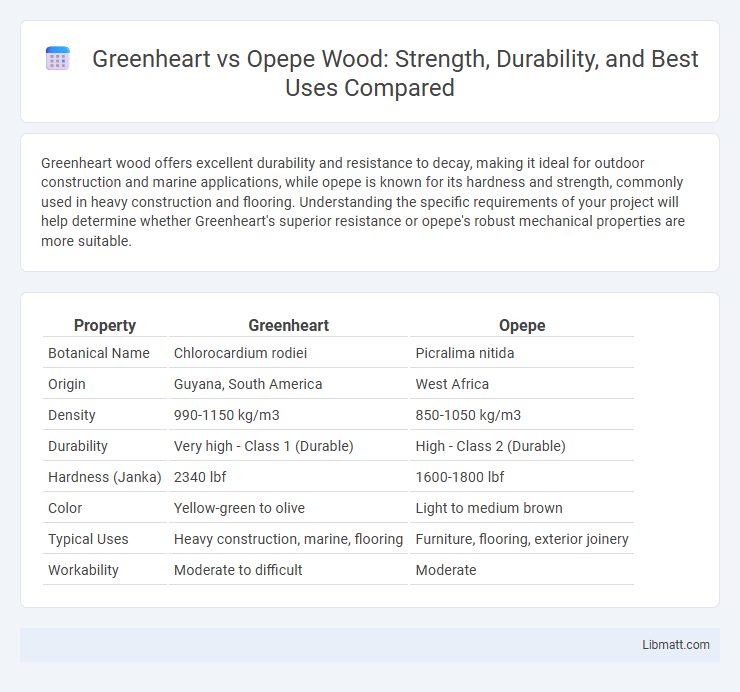Greenheart wood offers excellent durability and resistance to decay, making it ideal for outdoor construction and marine applications, while opepe is known for its hardness and strength, commonly used in heavy construction and flooring. Understanding the specific requirements of your project will help determine whether Greenheart's superior resistance or opepe's robust mechanical properties are more suitable.
Table of Comparison
| Property | Greenheart | Opepe |
|---|---|---|
| Botanical Name | Chlorocardium rodiei | Picralima nitida |
| Origin | Guyana, South America | West Africa |
| Density | 990-1150 kg/m3 | 850-1050 kg/m3 |
| Durability | Very high - Class 1 (Durable) | High - Class 2 (Durable) |
| Hardness (Janka) | 2340 lbf | 1600-1800 lbf |
| Color | Yellow-green to olive | Light to medium brown |
| Typical Uses | Heavy construction, marine, flooring | Furniture, flooring, exterior joinery |
| Workability | Moderate to difficult | Moderate |
Introduction to Greenheart and Opepe
Greenheart, known scientifically as Chlorocardium rodiei, is a dense, durable hardwood prized for outdoor construction due to its resistance to decay and insects. Opepe, or Nauclea diderrichii, is a tropical hardwood valued for its strength and resistance to wear, commonly used in heavy construction and marine applications. Understanding the unique properties of Greenheart and Opepe helps you select the ideal wood for projects requiring longevity and toughness.
Botanical Origins and Tree Species
Greenheart (Chlorocardium rodiei) originates from the Lauraceae family native to the Guiana Shield in South America, recognized for its exceptionally dense hardwood. Opepe (Nauclea diderrichii), belonging to the Rubiaceae family, is predominantly found in West African tropical rainforests, known for its durable but lighter timber. Both species are prized in heavy construction and marine applications due to their natural resistance to decay and pests.
Physical Properties Comparison
Greenheart (Chlorocardium rodiei) exhibits exceptional density, averaging around 940 kg/m3, making it one of the hardest and most durable hardwoods, whereas Opepe (Nauclea diderrichii) is slightly less dense, typically around 850 kg/m3. Greenheart's Janka hardness measures approximately 2,690 lbf, indicating superior resistance to wear and mechanical damage, while Opepe has a Janka hardness near 1,600 lbf, reflecting moderate hardness. Both woods display high natural durability, but Greenheart's greater density and hardness make it more suitable for heavy-duty construction and marine applications.
Durability and Resistance
Greenheart wood exhibits exceptional durability and resistance to decay, termites, and marine borers, making it ideal for heavy-duty construction and outdoor applications. Opepe also offers good resistance to insects and fungal attack but is generally less durable than Greenheart, especially in wet or marine environments. The high density and natural oils in Greenheart contribute to its superior longevity and robustness under harsh conditions.
Environmental Impact and Sustainability
Greenheart (Chlorocardium rodiei) offers significant environmental benefits due to its slow growth and natural resistance to pests, promoting sustainable forestry practices and reducing the need for chemical treatments. Opepe (Nauclea diderrichii), while durable and strong, tends to grow faster but often involves more intensive logging practices that can contribute to deforestation and habitat loss if not managed responsibly. Sustainable sourcing of Greenheart supports long-term forest health, whereas Opepe requires stricter regulations to mitigate its environmental impact and ensure regeneration.
Common Applications and Uses
Greenheart wood, prized for its exceptional durability and resistance to marine borers, is commonly used in heavy-duty outdoor applications such as marine construction, bridge building, and railway sleepers. Opepe wood, with its hardness and natural resistance to decay, is often utilized for flooring, joinery, and general construction where strength and longevity are essential. Your choice between Greenheart and Opepe should consider the specific environmental exposure and structural requirements of the project.
Workability and Processing Characteristics
Greenheart wood exhibits exceptional workability due to its fine texture and natural oils, which provide resistance to splitting and ease in machining. In contrast, Opepe wood, known for its density and hardness, often requires specialized tools and careful handling to avoid chipping during processing. Both woods perform well in outdoor applications; however, Greenheart's natural oils enhance its resistance to decay and insect attack, making it more favorable for durable, weather-exposed projects.
Cost and Availability
Greenheart wood is generally more expensive than opepe due to its sustainability certifications and limited commercial availability, making it a premium choice for eco-conscious projects. Opepe, sourced mainly from West Africa, tends to be more readily available and budget-friendly, often used in heavy construction and outdoor applications. Your decision may hinge on balancing the cost efficiency of opepe with the higher price but environmentally responsible option of greenheart.
Advantages and Disadvantages
Greenheart offers superior strength and durability, making it ideal for heavy construction and outdoor applications, while Opepe is valued for its natural resistance to rot and insect attacks in marine environments. However, Greenheart is heavier and harder to work with due to its density, potentially increasing labor costs, whereas Opepe may require more maintenance over time as it is less durable under constant moisture exposure. Your choice depends on whether you prioritize long-lasting structural integrity or easier handling combined with moderate environmental resistance.
Choosing Between Greenheart and Opepe
Choosing between Greenheart and Opepe depends on your project's durability needs and aesthetic preferences. Greenheart offers exceptional strength and resistance to marine borers, making it ideal for heavy-duty outdoor and marine applications. Opepe, while durable and cost-effective, suits less intensive uses where a natural tan-brown appearance is desired without compromising on moderate resistance to decay.
Greenheart vs opepe Infographic

 libmatt.com
libmatt.com